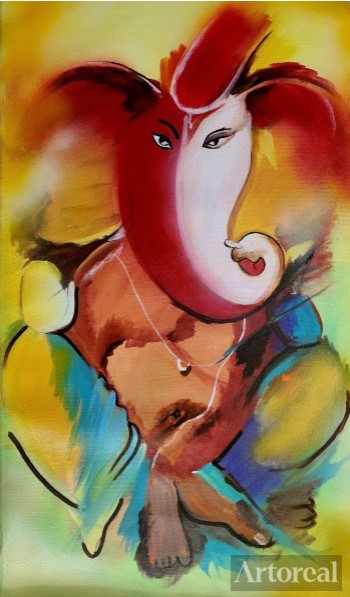There are several holy names that we call our favorite Lord by – Ananta, Avyakta, Achintya, Bappa, and so more. Ganesha is regarded as the Lord of all -the only consciousness penetrating and bringing the entire universe in order. Whenever any prosperous or Shubh event takes place, Lord Ganesha is the first deity that comes to our mind.
In India, a number of households -even in the modern century, look forward to adorning their interiors with bespoke Ganesha paintings or idols to reminisce of the positive presence all around. The most common deity of Indian paintings, you can come across a classic Ganesha painting across Indian art galleries. It is due to the overall creativity and flexibility of artists as well as art lovers when it comes to portraying the famous Lord Ganesha.
As you go through a random visit to any Indian art exhibition or gallery, you will be impressed to come across beautiful depictions of Lord Ganesha in different paintings and multiple other art forms. Ganesha seamlessly mingles with both artistic and mythical segments to be selected as your home décor item.

Ganesha Paintings -What are the Core Elements and Their Symbolic Meanings?
Ganesha has been beautifully depicted in various forms as well as patterns across several centuries. He has been powerfully linked with the Energy Wheel or the First Chakra. Therefore, Ganesha represents the overall well-being, survival, and conservation. In famous Ganesha paintings, you can come across depictions of the deity either seated or standing, playing any musical instrument, writing a scripture, eating ladoos, dancing, or even practicing yoga.
Ganesha is not just portrayed as the ultimate God but also as a friend to children. It is effectively depicted through celebrations of Ganesh Chaturthi that is celebrated with ample pomp & show. As different Ganesha paintings portray different faces and emotions of the Lord, every portrayal or art form is held in utmost esteem by art owners to seek blessings and protection.
As you consider bringing home a classic Ganesha painting, here are some common elements of a typical spiritual painting of lord Ganesh or depiction you should know about:
- The Gaj Mukh or Elephant Head: According to mythological beliefs, the head of an elephant was used to revive the head of Lord Ganesha who was beheaded by Lord Shiva in commotion and aggression. As he was given the gift of an elephant head, Lord Ganesha also received the blessing of being worshipped before all gods and goddesses by the humankind.
The head of the elephant and the body of the human symbolize ample wisdom along with a proper understanding of the universe. It also relates to the intellect that an individual is expected to possess to ensure perfection in life.
- Face Turning Left: Most artists are known to portray the classic Ganesha in different art forms. With the trunk of the Lord turning left, it is referred to as the art depicting Vastu Ganesha. The left side of these paintings symbolize feminine energy.
Just like the core feminine characteristics, the left side of the Lord in the painting depicts a calmer side of the deity. These Ganesha paintings are usually placed at corners of relaxation and calmness like meditation and Yoga centers. You can use this type of Ganesha painting for your home décor as well to emanate a sense of calm and peace throughout.
- Trunk Facing Right: When the Lord is referred to as the Siddhi Vinayak or Dakshinabhimukhi, an experienced artist will usually draw the painting with the trunk of the Lord facing right. This face of the Lord symbolizes masculine energy.
In this art form, the overall energy of the Lord is believed to be antagonistic and powerful. When the Lord is worshipped with the right trunk, you can start experiencing fast and effective results in life. Therefore, it is crucial to impress the aggressive note of the Lord as well.
- Painting Depicting a Broken or Missing Tusk: While worshipping, we refer to this depiction as the Ek Danta or the one with a single tusk. As per the mythological portrayals, one tusk was broken by the Lord himself to serve as the alternative to a pen when he had to compose the famous Mahabharata.
This painting symbolizes a wise individual going above the domains of duality. According to the principles of the Ek Danta, wisdom is the core characteristic that everyone should possess while observing everyone as equal.
- The Upraised or Blessing Hand: This aspect is quite common amongst paintings and art forms of deities in India. The upraised hand or palm of the God depicts the deity giving blessings to the humankind. This action ensures that the ultimate power is here to save as well as protect them from all types of adversities of life.
In addition to the upraised hand, there are paintings depicting a resting hand as well. It represents the ultimately giving nature of the Lord. The hand also serves as the gesture to invite devotees to seek ultimate blessings from the Lord.
The Evolution of Ganesha Paintings and Art Forms Over Time
From the image of only an elephant representing Lord Ganesha to depictions that are effectively paired with modern forms of art, the evolution of Ganesha paintings and other art forms has been quite inspiring. While the overall theme in modern paintings continues to remain the same, the style and medium have changed while catering to the newly developed tastes and preferences of art lovers.
Ganesha is the ultimate deity that represents an iconic symbolization of power, love, and blessings -all in one. While the overall style of depicting art form keeps changing from time to time, the basic elements of Ganesha paintings remain the same. He is depicted through arms in different forms and even numbers.
Ganesha is associated with luck, success, and prosperity in life. Nowadays, Ganesha paintings are created by bringing into effect a perfect blend of both traditional as well as modern forms of art.
